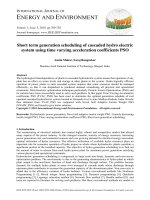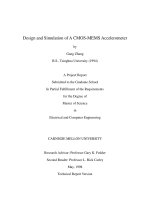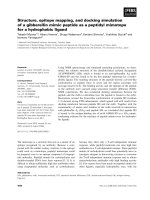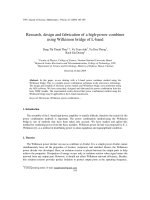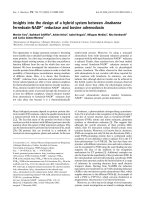Modeling and simulation of a hybrid electric vehicle using MATLAB/Simulink and ADAMS
Bạn đang xem bản rút gọn của tài liệu. Xem và tải ngay bản đầy đủ của tài liệu tại đây (2.16 MB, 100 trang )
Modeling and Simulation of
A Hybrid Electric Vehicle Using
MATLAB/Simulink and ADAMS
by
Brian Su-Ming Fan
A thesis
presented to the University of Waterloo
in fulfillment of the
thesis requirement for the degree of
Master of Applied Science
in
Mechanical Engineering
Waterloo, Ontario, Canada, 2007
© Brian Su-Ming Fan 2007
I hereby declare that I am the sole author of this thesis. This is a true copy of the thesis, including any
required final revisions, as accepted by my examiners.
I understand that my thesis may be electronically available to the public.
Signature
ii
Abstract
As the global economy strives towards clean energy in the face of climate change, the automotive
industry is researching into improving the efficiency of automobiles. Hybrid vehicle systems were
proposed and have demonstrated the capability of reducing fuel consumption while maintaining
vehicle performance. Various hybrid vehicles in the form of parallel and series hybrid have been
produced by difference vehicle manufacturers. The purpose of this thesis is to create a hybrid vehicle
model in MATLAB and ADAMS to demonstrate its fuel economy improvement over a conventional
vehicle system.
The hybrid vehicle model utilizes the Honda IMA (Integrated Motor Assist) architecture, where the
electric motor acts as a supplement to the engine torque. The motor unit also acts as a generator
during regenerative braking to recover the otherwise lost kinetic energy.
The powertrain
components power output calculation and the control logic were modeled in MATLAB/Simulink,
while the mechanical inertial components were modeled in ADAMS. The model utilizes a driver
input simulation, where the driver control module compares the actual and desired speeds, and applies
a throttle or a braking percent to the powertrain components, which in turns applies the driving or the
braking torque to the wheels. Communication between MATLAB and ADAMS was established by
ADAMS/Controls.
In order to evaluate the accuracy of the MATLAB/ADAMS hybrid vehicle model, simulation
results were compared to the published data of ADVISOR. The West Virginia University 5 Peaks
drive cycle was used to compare the two software models.
The results obtained from
MATLAB/ADAMS and ADVISOR for the engine and motor/generator correlated well.
Minor
discrepancies existed, but were deemed insignificant. This validates the MATLAB/ADAMS hybrid
vehicle model against the published results of ADVISOR.
Fuel economy of hybrid and conventional vehicle models were compared using the EPA New York
City Cycle (NYCC) and the Highway Fuel Economy Cycle (HWFET).
The hybrid vehicle
demonstrated 8.9% and 14.3% fuel economy improvement over the conventional vehicle model for
the NYCC and HWFET drive cycles, respectively. In addition, the motor consumed 83.6kJ of
electrical energy during the assist mode while regenerative braking recovered 105.5kJ of electrical
iii
energy during city driving. For the highway drive cycle, the motor consumed 213.6kJ of electrical
energy during the assist mode while the regenerative braking recovered 172.0kJ of energy.
The MATLAB/ADAMS vehicle model offers a simulation platform that is modular, flexible, and
can be conveniently modified to create different types of vehicle models. In addition, the simulation
results clearly demonstrated the fuel economy advantage of the hybrid vehicle over the conventional
vehicle model.
It is recommended that a more sophisticated power management algorithm be
implemented in the model to optimize the efficiencies of the engine and the motor/generator.
Furthermore, it is suggested that the ADAMS vehicle model be validated against an actual vehicle, in
order to fully utilize the multi-body vehicle dynamics capability which ADAMS has to offer.
iv
Acknowledgements
First and foremost, I would like to express my sincere gratitude to my thesis supervisors, Dr. Amir
Khajepour in the department of Mechanical and Mechatronics Engineering, and Dr. Mehrdad
Kazerani in the department of Electrical and Computer Engineering, for their guidance and patience
throughout the completion of my degree. This thesis was completed on a part-time basis, and would
have never materialized without their continuous understanding and support.
I would also like to express my thanks to my past and current supervisors at General Dynamics Land
Systems
Canada, Mr. Phong Vo and Mr. Zeljko Knezevic, for their advice and encouragement in
pursuing my academic degree throughout the course of my employment, and to allow time taken off
during the day to return to campus, and to stay numerous late nights and weekends at the office.
In addition, I would like to thank my thesis readers, Dr. John McPhee in the department of Systems
Design Engineering, and Dr. Madgy Salama in the department of Electrical and Computer
Engineering, for their thorough review and various suggestions to improve the quality of my thesis.
Last but not least, I would like to thank my family, my parents Ellen and K.C., and my sister Sharon.
No words can express my utmost appreciation for their unconditional support, inspiration, and
motivation over the years of pursuing this degree.
v
Table of Contents
Chapter 1 Introduction...................................................................................... 1
Chapter 2 Literature Review and Background .............................................. 4
2.1 Series Hybrid ................................................................................................................................4
2.2 Parallel Hybrid..............................................................................................................................5
2.3 Existing Design.............................................................................................................................6
2.3.1 Toyota ....................................................................................................................................6
2.3.2 Honda...................................................................................................................................11
2.3.3 Nissan...................................................................................................................................13
2.4 Summary.....................................................................................................................................16
Chapter 3 Hybrid Vehicle Modeling .............................................................. 17
3.1 Overall Structure.........................................................................................................................17
3.2 Powertrain Components..............................................................................................................19
3.2.1 Engine ..................................................................................................................................19
3.2.2 Motor/Generator ..................................................................................................................21
3.2.3 Battery System .....................................................................................................................24
3.2.4 Transmission ........................................................................................................................24
3.3 Controller Logic..........................................................................................................................25
3.3.1 Driver Logic.........................................................................................................................25
3.3.2 Power Management Logic ...................................................................................................26
3.3.3 Mechanical Brake Logic ......................................................................................................28
3.4 Mechanical Components.............................................................................................................28
3.4.1 Vehicle Body .......................................................................................................................29
3.4.2 Operating Environment........................................................................................................29
vi
Chapter 4 Software Structure......................................................................... 30
4.1 MATLAB/Simulink Model ........................................................................................................30
4.1.1 Drive Cycle ..........................................................................................................................31
4.1.2 Driver Control......................................................................................................................31
4.1.3 Power Management Controller ............................................................................................32
4.1.4 Engine ..................................................................................................................................34
4.1.5 Motor/Generator ..................................................................................................................34
4.1.6 Transmission ........................................................................................................................36
4.1.7 Mechanical Brake ................................................................................................................36
4.1.8 Battery System .....................................................................................................................37
4.1.9 ADAMS Subsystem.............................................................................................................38
4.2 ADAMS Model...........................................................................................................................39
4.2.1 Vehicle Chassis....................................................................................................................40
4.2.2 Suspension ...........................................................................................................................40
4.2.3 Driveline ..............................................................................................................................41
4.2.4 Steering System ...................................................................................................................41
4.2.5 Mechanical Brakes...............................................................................................................42
4.2.6 Tires and Road .....................................................................................................................43
4.3 Co-Simulation.............................................................................................................................44
4.3.1 ADAMS Plant Export ..........................................................................................................44
4.3.2 ADAMS/Control in MATLAB............................................................................................46
4.4 Model Validation with ADVISOR .............................................................................................47
4.4.1 Model Setup .........................................................................................................................48
4.4.2 Results Comparison .............................................................................................................50
Chapter 5 Simulation Results and Efficiency Comparison ......................... 56
5.1 New York City Cycle (NYCC)...................................................................................................58
5.1.1 Driving Behaviour ...............................................................................................................58
5.1.2 Efficiency Comparison ........................................................................................................60
5.2 Highway Fuel Economy Cycle (HWFET)..................................................................................64
5.2.1 Driving Behaviour ...............................................................................................................64
5.2.2 Efficiency Comparison ........................................................................................................66
vii
5.3 Summary.....................................................................................................................................69
Chapter 6 Conclusions and Recommendations............................................. 70
Bibliography ..................................................................................................... 72
Appendix A Engine Data................................................................................. 74
Appendix B Motor/Generator Data ............................................................... 76
Appendix C Mechanical Components Mass Properties............................... 78
Appendix D Steering System Controller ADAMS Definitions .................... 79
Appendix E Tire Property Definition File ..................................................... 82
Appendix F Road Property Definition File ................................................... 85
Appendix G ADAMS/Control Plant Definition ............................................ 86
Appendix H ADAMS/Control MATLAB .m File ......................................... 87
viii
List of Figures
Figure 2-1: Schematic of a Series Hybrid Electric Vehicle [1] ..............................................................4
Figure 2-2: Schematic of a Parallel Hybrid Electric Vehicle [1] ............................................................5
Figure 2-3: Toyota Power Management Principle [3] ............................................................................7
Figure 2-4: Toyota Hybrid System Schematic [3] ..................................................................................8
Figure 2-5: Toyota Hybrid System-CVT Schematic [3].........................................................................9
Figure 2-6: Toyota Hybrid System-Mild Schematic [3].......................................................................10
Figure 2-7: Honda IMA Schematic [1].................................................................................................11
Figure 2-8: Honda Civic Hybrid Schematic [1]....................................................................................12
Figure 2-9: Comparison of Engine and Motor Performance Efficiencies [7].......................................14
Figure 2-10: Nissan Tino Propulsion System Schematics [7] ..............................................................15
Figure 3-1: Honda's Integrated Motor Assist Powertrain Structure [1] ................................................17
Figure 3-2: Overall Structure of the Hybrid Vehicle Model.................................................................18
Figure 3-3: Maximum Engine Torque [10] ..........................................................................................19
Figure 3-4: Closed Throttle Torque [10] ..............................................................................................20
Figure 3-5: Engine Fuel Consumption Rate Data Map [10].................................................................21
Figure 3-6: Maximum Motor Torque [11]............................................................................................22
Figure 3-7: Maximum Generator Torque [11]......................................................................................22
Figure 3-8: Motor/Generator Efficiency Map [11] ...............................................................................23
Figure 3-9: Percent Throttle Closed-Loop Proportional Controller......................................................26
Figure 3-10: Percent Braking Closed-Loop Proportional Controller....................................................26
Figure 3-11: Control Logic for Activating Mechanical Brakes ............................................................28
Figure 4-1: Overall Model Structure in MATLAB/Simulink...............................................................30
Figure 4-2: Drive Cycle Subsystem......................................................................................................31
Figure 4-3: Driver Controller Subsystem .............................................................................................32
Figure 4-4: Power Management Subsystem .........................................................................................33
Figure 4-5: Engine Subsystem..............................................................................................................34
Figure 4-6: Motor/Generator Subsystem ..............................................................................................35
Figure 4-7: Transmission Subsystem....................................................................................................36
Figure 4-8: Mechanical Brake Subsystem ............................................................................................37
Figure 4-9: Battery Subsystem .............................................................................................................38
Figure 4-10: ADAMS Subsystem.........................................................................................................38
ix
Figure 4-11: Mechanical Components of the Vehicle Model in ADAMS/View..................................39
Figure 4-12: Close Up View of the Front Suspension, Driveline and Steering System .......................40
Figure 4-13: Closed Loop Steering Controller .....................................................................................41
Figure 4-14: Mechanical Brake Torque Element in ADAMS ..............................................................43
Figure 4-15: Defining Front Left Tire Element in ADAMS.................................................................44
Figure 4-16: Defining Plant Export for ADAMS/Control ....................................................................45
Figure 4-17: Simulation Parameters for ADAMS/Control in MATLAB/Simulink .............................47
Figure 4-18: ADVISOR 2002 Startup Window....................................................................................48
Figure 4-19: West Virginia University 5 Peaks Drive Cycle................................................................49
Figure 4-20: WVU 5 Peaks Drive Cycle Vehicle Speed Comparison..................................................50
Figure 4-21: WVU 5 Peaks Drive Cycle Engine Speed Comparison...................................................51
Figure 4-22: WVU 5 Peaks Drive Cycle Engine Torque Comparison .................................................52
Figure 4-23: WVU 5 Peaks Drive Cycle Motor/Generator Torque Comparison .................................53
Figure 4-24: WVU 5 Peaks Drive Cycle Fuel Rate Comparison .........................................................54
Figure 4-25: WVU 5 Peaks Drive Cycle State of Charge Comparison ................................................55
Figure 5-1: EPA New York City Cycle (NYCC) Standard Drive Cycle..............................................57
Figure 5-2: EPA Highway Fuel Economy (HWFET) Standard Drive Cycle .......................................57
Figure 5-3: NYCC Hybrid and Conventional Vehicle Speed Comparison ..........................................58
Figure 5-4: NYCC Hybrid and Conventional Vehicle Throttle Percent Comparison ..........................59
Figure 5-5: NYCC Hybrid and Conventional Vehicle Braking Percent Comparison ..........................60
Figure 5-6: NYCC Hybrid and Conventional Vehicle Fuel Consumption Comparison ......................61
Figure 5-7: NYCC Hybrid and Conventional Vehicle Battery State of Charge Comparison ..............62
Figure 5-8: HWFET Hybrid and Conventional Vehicle Speed Comparison........................................64
Figure 5-9: HWFET Hybrid and Conventional Vehicle Throttle Percent Comparison........................65
Figure 5-10: HWFET Hybrid and Conventional Vehicle Braking Percent Comparison......................66
Figure 5-11: HWFET Hybrid and Conventional Vehicle Fuel Consumption Comparison..................67
Figure 5-12: HWFET Hybrid and Conventional Vehicle Battery State of Charge Comparison..........68
x
List of Tables
Table 2-1: Toyota Prius THS Specification [2] .................................... Error! Bookmark not defined.
Table 2-2: Toyota Estima THS-C Specification [2] ...............................................................................9
Table 2-3: Toyota Crown THS-M Specification [4].............................................................................10
Table 2-4: Honda Civic Hybrid Powertrain Specification [1] ..............................................................13
Table 2-5: Nissan Tino Powertrain Specification [7] ...........................................................................15
Table 3-1: Transmission Gear Ratio and Corresponding Vehicle Speed [12]......................................25
Table 3-2: Control Logic for Activating Motor Assist Mode...............................................................27
Table 3-3: Control Logic for Activating Regenerative Braking Mode. Error! Bookmark not defined.
Table 5-1: NYCC Fuel Consumption Summary of the Hybrid and the Conventional Vehicle Model 61
Table 5-2: NYCC Electrical Energy Consumption Summary of the Hybrid Vehicle ..........................63
Table 5-3: NYCC Fuel Economy Summary of the Hybrid and the Conventional Vehicle Model.......63
Table 5-4: HWFET Fuel Consumption Summary of the Hybrid and the Conventional Vehicle Model
......................................................................................................................................................67
Table 5-5: HWFET Electrical Energy Consumption Summary of the Hybrid Vehicle .......................68
Table 5-6: HWFET Fuel Economy Summary of the Hybrid and the Conventional Vehicle Model....69
xi
Nomenclature
Tout
Motor torque output [Nm]
Pdesired
Desire motor power [W]
engine
Engine speed [rad/s]
Consumed or generated by the motor/generator [J]
Pmogen
Power consumed or generated by the motor/generator [W]
Pmax
Maximum power output available from the engine and the motor combined [W]
%throttle
Throttle input percent by the driver [W]
Fd
Vehicle drag force [N]
CD
Drag coefficient of the Honda Insight
A
Frontal area of the Honda Insight [m2]
air
Density of air [kg/m3]
vact
Actual vehicle velocity [m/s]
steeringoutput
Steering controller output signal [mm]
steeringdesired
Desired vehicle steering path in Y-coordinate [mm]
steeringactual
Actual vehicle steering path in Y-coordinate [mm]
steeringgain
Proportional steering closed loop controller gain value
Fuelequiv
Equivalent fuel amount of the motor/generator s electrical energy [L]
elec
Electrical Energy of the motor/Generator [J]
fuel
Density of gasoline [g/L]
lhvfuel
Lower heating value (does not contain water vapour energy) of gasoline [J/g]
xii
Chapter 1
Introduction
As the global economy strives towards clean energy in the face of climate change, the industrial
world is researching into alternative sources of energy. Since automobiles are currently a major
source of air pollution, governments and major automotive companies are collaborating to provide a
solution that will result in the reduction of vehicle emissions, while reducing the consumption of
fossil fuel.
Various forms of fossil fuel reduction methods and alternative power sources are
currently researched by different manufacturers. The two notable categories in research are internal
combustion (IC) engine vehicles and electric vehicles. Fuels presently utilized in internal combustion
engine vehicle include turbo or supercharging gasoline, diesel, methanol, and natural gas. The energy
path of the IC engine is to transform the energy content of various fuel sources into kinetic energy
that propels the vehicle forward. This is accomplished by using the expansion of burning fuel in a
chamber to provide a translational motion to propel the wheels. The advantage of IC engine is that
fuels with high-energy content can be transported easily, while the disadvantage is that the burning of
fuels creates emissions that are hazardous to the environment. Alternatively, the electric vehicle uses
electric energy from a battery or fuel cell, and converts it into kinetic energy via electric motors. The
advantage of an electric vehicle is that zero emissions are produced when the electric energy is
converted into kinetic energy. Various methods of providing electric energy are currently being
explored.
Conventional battery is one method of storing electric energy, although current
technologies prevent a working solution with reasonable vehicle mileage. Hydrogen fuel cell is an
alternative method of storing electrical energy; however, current technologies have not matured yet to
provide a safe storage of hydrogen.
In search for a working solution, a hybrid vehicle system which combines the advantages of both
power sources (IC engine and battery), was proposed. By definition, a hybrid vehicle is one that
employs two or more power sources to improve the overall efficiency of the vehicle. By combining
an internal combustion engine with an electric battery-motor system, the goal of fuel portability can
be solved. In addition to achieving low emission and fuel consumption requirement, hybrid electric
1
2
vehicle can recapture the otherwise lost kinetic energy during the braking cycle, thus further
improving the efficiency of the vehicle system. Hybrid vehicle systems can also be utilized for
military application. By using the electric power source during vehicle idling, minimal thermal
signature is released, thus lowering the chances of enemy detection.
In order to increase the efficiency and accuracy of automotive design, Computer Aided
Engineering (CAE) has been playing an ever increasing role throughout the process of vehicle design.
With the increase of computing power, manufacturers are now able to perform design, testing, and
optimization of a vehicle through computer simulation, all prior to the actual manufacturing of a
vehicle. Similar to other areas of automotive research such as vehicle dynamics and crash worthiness,
numerous software packages were developed in order to evaluate the energy efficiencies of the hybrid
electric vehicle. One particular example is a software originally developed by the U.S. Department of
Energy (DOE) and the National Renewable Energy Laboratory (NREL) called ADVISOR (Advanced
Vehicle Simulator), which was later acquired by AVL Powertrain Engineering, Inc. ADVISOR is a
software based on MATLAB/Simulink that can be used to simulate and analyze light and heavy
vehicles, including hybrid and fuel cell vehicles, where it allows the user to customize the power
components such as internal combustion engines and electric motors to study the effect on fuel
efficiency and vehicle performance.
The purpose of this thesis is to create a MATLAB/ADAMS hybrid vehicle model that
demonstrates the fuel efficiency advantage of a hybrid vehicle. Current hybrid vehicle simulation
software such as ADVISOR can only simulate vehicle performances from an energy standpoint and
does not consider the complexity of multi-body dynamics of a vehicle system. Similarly, vehicle
dynamics simulation software tends to focus on the dynamic performance of a vehicle, and does not
consider the energy efficiency of the vehicle s powertrain components. The MATLAB/ADAMS
simulation platform of this thesis will combine the capabilities of both fields to allow the user to
perform powertrain design studies on a hybrid electric vehicle in a multi-body dynamic environment.
The MATLAB/ADAMS simulation platform of this thesis consists of a simple hybrid electric
vehicle system based on the mechanical and powertrain components of the Honda Insight using its
IMA (Integrated Motor Assist) architecture, where the electric motor will act as an assisting device to
complement the engine. The Honda IMA system was chosen since it was the least complex of all
3
hybrid systems. The mechanical components of the vehicle body were created in MSC ADAMS,
while the power components and the power management logic were modeled in MATLAB/Simulink.
Chapter 2 will further discuss various configurations of hybrid electric vehicles, and also provide an
overview of existing hybrid vehicle designs available on the market. Chapter 3 will present the
overall structure of the hybrid vehicle and its components in detail. Chapter 4 will discuss the
software structure of the simulation platform used to simulate the hybrid vehicle. Comparison of
simulation results obtained from the MATLAB/ADAMS simulation platform and ADVISOR will be
presented. Chapter 5 will contain comparative analysis of hybrid and conventional vehicle simulation
based on the ADAMS/MATLAB vehicle model. City and highway standard drive cycles will be used
to simulate the performance and the fuel efficiency of the hybrid and conventional vehicles. Finally,
Chapter 6 will conclude the modeling and simulation of the MATLAB/ADAMS hybrid vehicle
model, and provide recommendations for further improvement of the vehicle system.
Chapter 2
Literature Review and Background
The most successful hybrid configuration currently utilized by various vehicle manufacturers consists
of a diesel or gasoline engine, coupled with a motor and a generator linked with a battery system.
Although there are many different hybrid configurations currently proposed by vehicle
manufacturers, most configurations can be categorized into two hybrid systems: Series Hybrid and
Parallel Hybrid.
2.1 Series Hybrid
In the series hybrid system, the IC engine drives the generator, and electricity is supplied to the
battery. The electrical energy from the battery is then received by the motor, which in turns drives
the wheels to propel the vehicle. Figure 2-1 illustrates the system configuration of a series hybrid
electric vehicle. [1]
Figure 2-1: Schematic of a Series Hybrid Electric Vehicle [1]
The advantage of the series hybrid is that the engine runs at its best efficiency, thus generating the
maximum electrical energy to charge the battery. Since the engine is constantly operating at its
optimum efficiency, and the vehicle receives its power solely from the electric motor, this system is
4
5
most efficient during the stop and go of city driving. In addition, the internal combustion engine of
the series hybrid vehicle can be replaced by a fuel cell, thus converting it into a pure electric vehicle.
The disadvantage of a series hybrid vehicle is that the efficiency of the system is reduced during
highway driving cycles. During highway driving, the engine has to convert fuel energy to electrical
energy, which will be converted again to kinetic energy to drive the wheels. Energy loses during
conversion in addition to lower torque output of the electric motor at high rotational speeds
contributes to the overall lower efficiency of the system.
2.2 Parallel Hybrid
The parallel hybrid configuration switches between the two power sources, i.e., the internal
combustion engine and the electric motor drive, where the high efficiency range of each is selected
and utilized. Depending on the situation, both power sources can also be used simultaneously to
achieve the maximum power output. Figure 2-2 shows the system configuration of a parallel hybrid
electric vehicle. [1]
Figure 2-2: Schematic of a Parallel Hybrid Electric Vehicle [1]
The advantage of a parallel hybrid vehicle is that the system has the ability to offer higher
efficiency during highway driving condition. During highway driving, the vehicle speed does not
vary significantly and therefore it is more efficient to drive the wheels directly from the IC engine. In
addition, the electric motor can be used solely during city driving while the IC engine recharges the
battery, thus providing higher overall efficiency. In addition, both power sources can be utilized
simultaneously to provide maximum performance of the vehicle.
6
2.3 Existing Design
Various automakers have successfully introduced hybrid electric vehicles into the automobile market.
The following sections describe the system configuration of the most popular hybrid vehicles that are
currently on the market.
2.3.1 Toyota
Toyota launched the Prius, the world s first mass-produced hybrid vehicle in 1997, and introduced the
vehicle to the US and Europe in 2000. The Estima and the Crown Mild hybrid vehicle were placed in
the Japanese market following the Prius. Currently, Toyota has over 100,000 hybrid vehicles in the
automotive market. Toyota has developed three different Hybrid systems for the vehicles: THS
(Toyota Hybrid System) for the Prius, THS-C (Toyota Hybrid System
THS-M (Toyota Hybrid System
CVT) for the Estima, and
Mild) for the Crown. [2, 3, 4, 5]
Energy Management Principle
Figure 2-3 shows the energy management principle of the Toyota hybrid vehicles. Due to the fact
that the engine has different energy conversion efficiencies at different points in the operating range,
a battery is used to store or supply energy to ensure maximum efficiency is achieved during a typical
drive cycle. When the vehicle accelerates, the additional energy is supplied from the battery, while
the engine runs in the optimum efficiency range to supply the power required by the load. During
cruising of the vehicle, the engine is still operating in the maximum efficiency range, and depending
on the demand, excess energy is stored back in the battery. Energy can be supplied from the battery if
the vehicle needs to operate at a higher load. Finally, during deceleration, the engine is turned off,
and the braking energy is recovered by a generator and is returned to the battery. This state of
operation is often referred to as regenerative braking. Depending on the state of the charge of the
battery, the engine can remain on to charge the battery while still regenerative braking is performed.
[3]
7
Figure 2-3: Toyota Power Management Principle [3]
THS (Prius) System
The Toyota Prius is the hybrid vehicle marketed by Toyota in the compact sedan segment. Figure 2-4
illustrates the schematic diagram while Table 2-1 summarizes the specification of the Prius THS.
This system is a combination of parallel and series hybrid system, thus achieving the advantages of
both systems. A gasoline engine and an electric motor are utilized as the power sources, with the
gasoline engine remains as the main power source. The power produced by the gasoline engine is
distributed to drive the wheels as well as the generator via a set of planetary gears. Depending on the
mode of operation, the engine power can be used to solely drive the wheels, be distributed between
the wheels and the generator, or be used solely to power the generator. The engine can also be
completely shut off if the battery is fully charged. The generated electric power can be used to drive
the motor, or is converted into direct current and stored in a high voltage battery. [3, 5]
8
Figure 2-4: Toyota Hybrid System Schematic [3]
Table 2-1: Toyota Prius THS Specification [2]
Curb Weight
1,220kg
Battery
21kW, 274V, 6.5Ah
Motor Generator
33kW
Engine Max Power
53kW @ 4500rpm
Engine Max Torque
115Nm @ 4200rpm
THS-C (Estima) System
The Toyota Estima Hybrid is the hybrid vehicle marketed by Toyota in the mini-van segment in
Japan. Figure 2-5 depicts the configuration while Table 2-2 summarizes the specification of the
Estima THS-C. This system is based on the THS (Prius) system with the addition of an electric
motor to power the rear wheels, thus creating a rear drive unit that is mechanically separated from the
front system, eliminating the need for transfers or propeller shafts. The result is the construction of a
4WD system that satisfies the demands of a mini-van.
The transaxle of the front drive unit
incorporates a CVT (Continuous Variable Transmission) that achieves excellent driving comfort with
smooth speed change. [2, 3]
9
Figure 2-5: Toyota Hybrid System-CVT Schematic [3]
Table 2-2: Toyota Estima THS-C Specification [2]
Curb Weight
1,850kg
Battery
216V, 6.5Ah
Front Motor Generator
13kW
Engine Max Power
96kW @ 4500rpm
Engine Max Torque
190Nm @ 4200rpm
Rear Motor Generator
18kW
THS-M (Crown) System
The Crown mild hybrid is a luxury sedan introduced in the Japanese market. The mild hybrid differs
from previous systems in that the motor-generator is not used to drive the wheels. Instead it is used to
power the auxiliary devices such as air conditioner and power steering, and is used to recover the
otherwise lost energy during deceleration during braking. In addition, it is also used to start the
engine during the idle stop operation. In order to maximize the fuel economy of the system, the
engine is turned off when the vehicle is at a stop. When the vehicle starts moving, the motor will
instantly start the engine, thus allowing the vehicle to start instantly. Figure 2-6 shows the schematic
of the THS-M system. The motor-generator in this system is connected to the engine via the engine
belt. The motor-generator is connected to the inverter unit, which is then connected to the batteries.
10
The 42-V power supply system was selected due to the fact that it not only meets the high power
requirement unique to the hybrid vehicle, but also the increasing electrical loads of existing vehicles.
In addition, since international standardization of the 42-V power supply system has been publicized
as the next generation power supply system, it is cost-efficient to incorporate the new system into the
hybrid components. [3, 4] Table 2-3 summarizes the motor-generator specification utilized on the
Crown mild hybrid vehicle [4].
Figure 2-6: Toyota Hybrid System-Mild Schematic [3]
Table 2-3: Toyota Crown THS-M Specification [4]
Motor Type
AC Synchronous Motor
Rated Voltage
36V
Power Rating
Drive
3.0kW
Generation
3.5kW
Maximum Torque
56.0Nm (0-300rpm)
Permissible Max. Speed
15,000rpm
Cooling Method
Air Cooling
11
2.3.2 Honda
Currently, Honda has two hybrid electric vehicles on the market: the Insight and the Civic Hybrid.
The Insight is a two door coupe that was introduced in 1999, and is the first vehicle to contain the
Honda IMA (Integrated Motor Assist) system. The Civic Hybrid was made available in 2002, and
has a modified IMA system that is fitted to the Civic s 5-passenger 4-door sedan body. The Insight
achieved a fuel consumption rate of 3.4L/100km, while the Civic Hybrid with the manual
transmission attained 5.1L/100km and 4.6L/100km in the city and on the highway respectively. [1, 6]
Integrated Motor Assist (IMA) System
The IMA system schematic is shown in Figure 2-7. In this system, a permanent magnet DC brushless
motor is placed with direct crankshaft connection between the engine and the transmission. The IMA
system uses the engine as the main power source, while the motor acts as an auxiliary power source
when accelerating. By using the motor as an auxiliary power source, the overall system is simplified,
and it is possible to use compact and light-weight motor, battery, and power control unit, thus
reducing the overall weight of the vehicle. [1]
Figure 2-7: Honda IMA Schematic [1]
Figure 2-8 illustrates the vehicle layout of the Civic Hybrid vehicle. The powertrain which
includes the engine, motor, and the transmission, is placed in the front of the vehicle. The Intelligent
Power Unit (IPU) along with the Power Control Unit (PCU) that controls the motor and the battery is
placed in the rear of the vehicle.
12
Figure 2-8: Honda Civic Hybrid Schematic [1]
System Description
Three techniques were employed to increase the overall efficiency of the system: [1]
1. Deceleration Energy Regeneration and Acceleration Assist
2. Idle Engine Stop
3. Reduction in Engine Displacement
Conventionally, kinetic energy is lost by braking and engine friction during deceleration. By utilizing
the motor as a generator, the otherwise lost energy can be recovered into useful electric energy, and
can be used during acceleration, thus increasing the efficiency. Secondly, by shutting off the engine
during vehicle idling, fuel is not consumed, therefore reducing unnecessary fuel consumption.
Finally, by having a motor for auxiliary power, it is possible to achieve the required dynamic
performance through the combination of the engine and the motor. Therefore, it is possible to reduce
the engine displacement, which further reduces the fuel consumption. Table 2-4 summarizes the
powertrain specification of the Honda Civic Hybrid. [1]
13
Table 2-4: Honda Civic Hybrid Powertrain Specification [1]
Engine
Transmission
Motor (Assist)
Motor (Regeneration)
Battery
Inline 4-cylinder 1.3 liter i-DSI lean-burn SOHC engine
Max Power (kW/rpm): 63/5700
Max Torque (Nm/rpm): 119/3300
Continuous Variable Transmission (CVT) or Manual Transmission
(MT)
DC Brushless Motor
Max Power: 10kW
Max Torque: 62Nm (Starter); 103Nm
Max Power: 12.3kW (MT), 12.6kW(CVT)
Max Torque: 108Nm
Nickel Metal Hydride (Ni-MH)
2.3.3 Nissan
Nissan developed the Tino hybrid electric vehicle which was launched in Japan in March 2000. The
development goal of the Tino hybrid is to achieve a fuel economy twice as good as that of the
conventional vehicle. The following measures were used by Nissan to achieve the reduction in fuel
consumption: [7]
Recover braking energy to store in the battery
Eliminate idling
Enhance engine efficiency and increase the frequency driven under such efficiency range
Drive with motor-generated power in low engine load ranges using the power recovered from
deceleration energy or generated under high engine efficiency ranges
The comparison of efficiency between the motor and the engine utilized by the Tino Hybrid is
shown in Figure 2-9.

